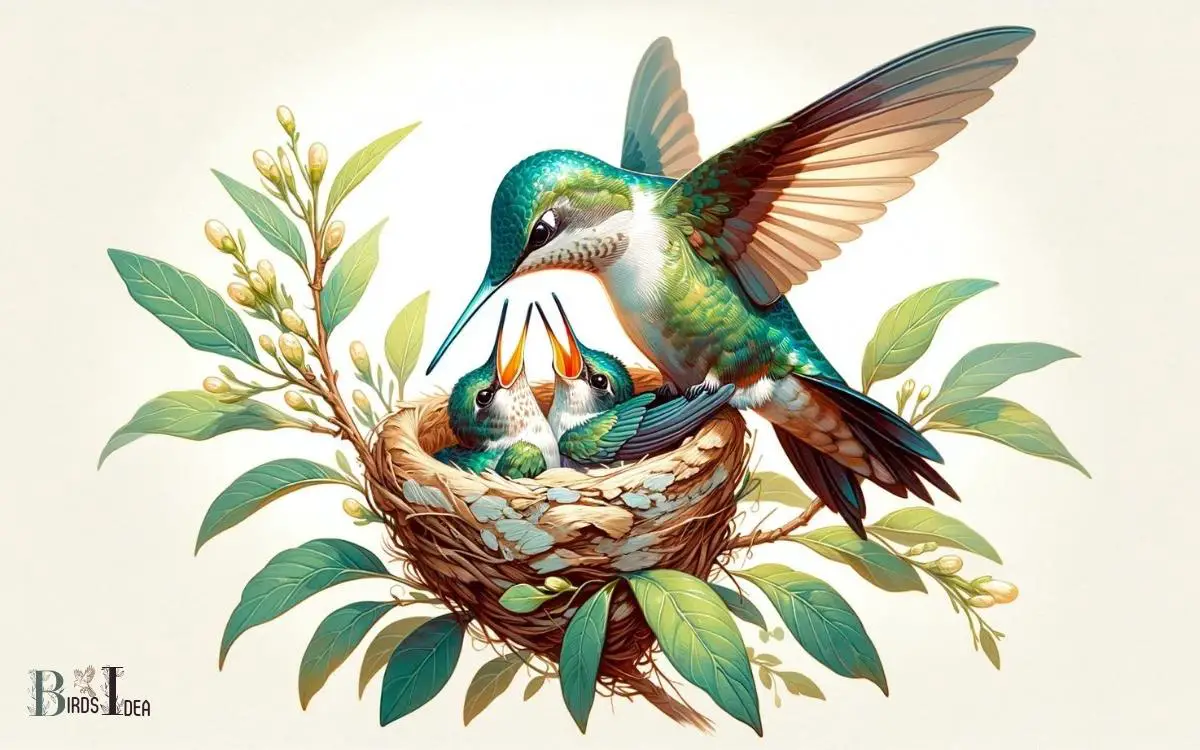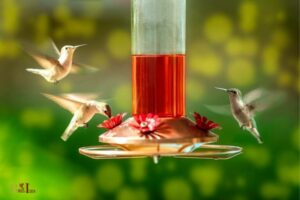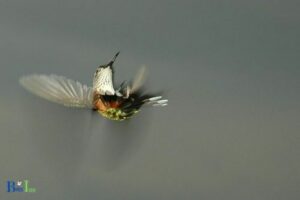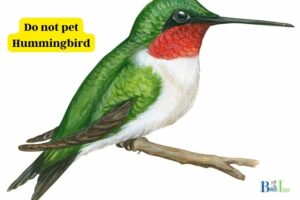How Do Mother Hummingbirds Feed Their Young? Discover!
Mother hummingbirds are like tireless chefs, serving up a special blend of nectar and insects to nourish their young.
Their feeding technique is a delicate dance, involving regurgitation and precise beak-to-beak transfers.
These tiny birds cater to their chicks’ nutritional needs, ensuring a steady supply of food to fuel their rapid growth.
As the chicks mature, the feedings become more frequent, propelling them toward independence.
This intricate process of nurturing and sustenance shapes the remarkable journey of mother hummingbirds and their young.

Key Takeaway
The Nectar-Feeding Strategy
Mother hummingbirds use a precise nectar-feeding strategy to provide essential nutrition to their young.
They gather nectar from flowers using their specialized long, tubular beaks and extendable, straw-like tongues.
This strategy allows them to efficiently extract the nectar while pollinating the flowers in the process.
Once the nectar is collected, the mother hummingbird regurgitates it into the mouths of her chicks, providing them with a diet rich in sugars, amino acids, vitamins, and minerals crucial for their growth and development.
This precise feeding method ensures that the young hummingbirds receive the necessary nutrients to thrive.
The mother’s ability to locate and extract nectar from flowers, coupled with her instinctual regurgitation to feed her offspring, highlights the remarkable adaptation and caregiving behavior of these tiny birds.
Nesting and Egg Incubation
Upon selecting a suitable nesting site, the hummingbird begins the process of egg incubation, diligently maintaining the proper temperature and humidity to ensure the successful development of her offspring.
The nesting and egg incubation process is crucial for the survival of hummingbird chicks.
Here are three key aspects of this fascinating behavior:
- Nest Construction: Hummingbirds intricately weave their nests using plant fibers, spider silk, and other soft materials, creating a secure and insulated environment for their eggs.
- Incubation: The mother hummingbird dedicates herself to the task of incubating the eggs, using the warmth of her body to regulate the temperature and ensure optimal conditions for the embryos to develop.
- Parental Care: During incubation, the mother carefully tends to the eggs, constantly monitoring and adjusting her position to provide the necessary warmth and protection until hatching.
Regurgitation and Feeding Technique
After successfully incubating the eggs, hummingbird mothers use a regurgitation technique to feed their young, providing them with necessary nutrients for their growth and development.
This process involves the mother regurgitating partially digested nectar and insects into the mouths of the chicks.
The table below outlines the components of the regurgitated food and the feeding technique employed by mother hummingbirds.
| Nutrient | Source | Function |
|---|---|---|
| Proteins and fats | Insects | Essential for growth and energy |
| Sugars | Nectar | Provides energy for metabolic processes |
| Vitamins and minerals | Nectar and insects | Supports overall health and development |
This feeding technique ensures that the chicks receive a balanced diet, promoting their healthy development. The regurgitation process also establishes a strong bond between the mother and her offspring, fostering a crucial aspect of their nurturing and care.
Transitioning into the subsequent section about the ‘nutritional requirements of hummingbird chicks’, it is vital to understand the significance of the nutrients provided through this regurgitation feeding technique.
Nutritional Requirements of Hummingbird Chicks
Hummingbird chicks’ nutritional requirements encompass a diverse array of essential nutrients crucial for their growth and development.
- Protein: Hummingbird chicks require high levels of protein for proper development, as it’s essential for muscle and tissue growth.
- Fats: Fats provide a concentrated energy source crucial for the rapid growth and development of hummingbird chicks.
- Micronutrients: Micronutrients such as vitamins and minerals play a vital role in the overall health and development of hummingbird chicks, supporting functions like bone development, immune system functioning, and energy metabolism.
Hummingbird chicks require a diet that’s high in protein and fats to support their rapid growth and development. Additionally, they need a range of micronutrients to ensure proper bone development, immune system functioning, and energy metabolism.
Meeting these nutritional requirements is essential for the survival and health of hummingbird chicks.
Frequency and Quantity of Feedings
Mother hummingbirds feed their young approximately 5-8 times per hour to sustain their high metabolic rate and rapid growth. This frequent feeding is essential due to the high energy demands of the chicks.
The quantity of nectar or insects consumed during each feeding is relatively small, as the young hummingbirds have tiny stomachs and can only consume a small amount of food at a time.
The high frequency of feedings ensures that the chicks receive a continuous supply of nutrients to support their development.
The precise timing and quantity of feedings are crucial for the chicks’ growth and survival, as they require a constant supply of energy to maintain their body temperature and fuel their rapid metabolism.
This intensive feeding schedule highlights the remarkable dedication of mother hummingbirds to nurturing their young.
Growth and Development Milestones
During the first week, young hummingbirds progress from being blind and featherless to opening their eyes and developing tiny, downy feathers. As they continue to grow and develop, they reach several key milestones.
- Feeding Independence: By the end of the second week, young hummingbirds start to leave the nest and learn to feed on their own, although they may still rely on their mother for guidance and support.
- Flight Readiness: Around three weeks of age, their flight feathers become fully developed, enabling them to practice hovering and flying in preparation for independence.
- Fledging: At about four weeks old, the young hummingbirds are fully fledged and ready to leave the nest, beginning their journey into the world as independent birds.
These milestones mark the remarkable growth and development of young hummingbirds as they transition from helpless hatchlings to self-sufficient flyers.
Fledging and Independence
As mother hummingbirds approach the end of their parental care period, their young begin to exhibit nest departure behaviors. These behaviors include fluttering their wings and exploring the area around the nest.
During this time, the young hummingbirds also start to learn food sources and become more independent in their foraging.
As the fledging process progresses, there’s a shift in the parental role, with the mother gradually reducing the amount of feeding and guidance provided to her offspring.
Nest Departure Behaviors
The young hummingbirds instinctively begin to explore their surroundings as they prepare to fledge from the nest.
This crucial phase of their development involves several notable behaviors:
- Wing exercises: The young birds engage in wing-flapping exercises to strengthen their flight muscles and coordination, essential for their upcoming first flight.
- Hovering practice: They practice hovering near the nest, mimicking the foraging behaviors of their parents and honing the skills they’ll need to obtain food independently.
- Exploratory flights: The fledglings venture cautiously from the nest, gradually extending the duration and distance of their flights as they become more proficient fliers.
These behaviors are vital as the young hummingbirds transition towards independence and learning to fend for themselves.
Next, let’s examine how they learn to identify and access food sources in their environment.
Learning Food Sources
Fledgling hummingbirds frequently observe and imitate their parents’ foraging behaviors to learn how to access food sources and become independent feeders. This observational learning is crucial for their survival and development.
As they accompany their parents on foraging trips, young hummingbirds gain essential skills such as identifying flowers with nectar, catching small insects, and understanding the importance of a varied diet.
Through trial and error, they learn to use their specialized beaks and long tongues to extract nectar from flowers and snatch insects mid-flight.
This learning process is a gradual one, and as the fledglings become more proficient, they gradually gain independence in finding and accessing food sources.
The table below provides a comparison of the foraging behaviors of adult hummingbirds and fledglings:
| Foraging Behaviors | Adult Hummingbirds | Fledgling Hummingbirds |
|---|---|---|
| Nectar Collection | Visits various | Observes and imitates |
| flowers for nectar | parents’ nectar | |
| collection techniques | ||
| Insect Catching | Catches insects | Learns to catch insects |
| mid-flight | by observing parents | |
| Independence Level | Independent | Gradually becomes |
| forager | independent forager |
Parental Role Shift
After learning food sources, fledgling hummingbirds undergo a parental role shift as they begin to develop independence in foraging and feeding.
This shift marks an essential stage in the young hummingbird’s life as it prepares to transition from relying on parental care to becoming self-sufficient.
- Increased Foraging Abilities: Fledgling hummingbirds start to venture out more and explore their surroundings to find food sources independently.
- Decreased Parental Feeding: Parent hummingbirds gradually reduce the frequency of feeding their young, encouraging them to rely on their own foraging skills.
- Transition to Independence: As fledglings become more proficient in finding nectar and small insects, they gradually become less reliant on their parents for sustenance, ultimately reaching full independence.
During this phase, parent hummingbirds closely monitor their fledglings’ progress, providing guidance and protection as the young birds gain the skills necessary for survival in the wild.
Conclusion
Mother hummingbirds exhibit remarkable dedication and skill in feeding their young. Their ability to provide the necessary nutrients and care for their chicks is truly awe-inspiring.
The intricate process of regurgitation and feeding, coupled with the precise timing and frequency of feedings, ensures the healthy growth and development of the chicks.
It’s truly a marvel to witness the unwavering commitment of mother hummingbirds in nurturing their offspring.






